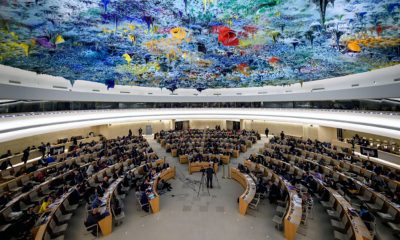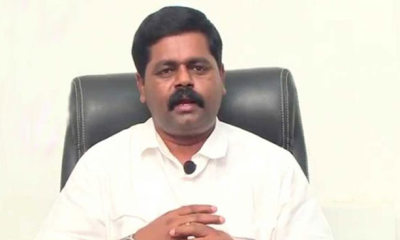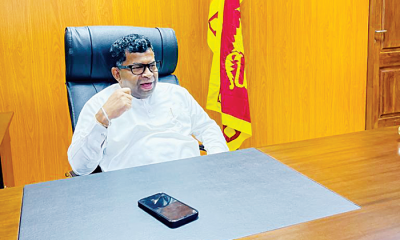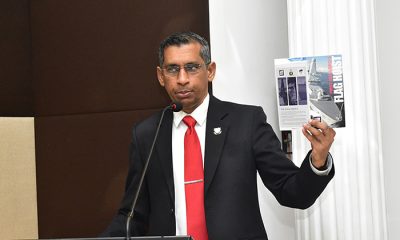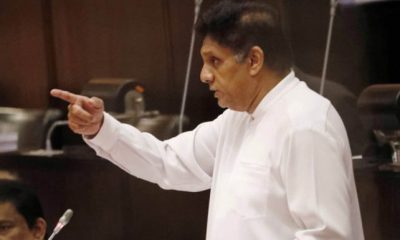Features
US lawmakers’ ignorance of civilian casualties in Lanka’s war on terrorism

by Daya Gamage
Foreign Service National Political Specialist (ret) US Department of State
Declaring that the government of Sri Lanka, while combating ‘Tamil Organizations’ which were fighting for a Tamil Homeland in the North-East, committed genocide against the Tamil people, a resolution was tabled in the US House of Representatives, on May 15, 2024, to coincide with the 15th anniversary of the conclusion of the LTTE’s terrorist war; it states, “Recognizing the hundreds of thousands of lives lost during Sri Lanka’s almost 30-year armed conflict, which ended 15 years ago on May 18, 2009, and ensuring nonrecurrence of past violence, including the Tamil Genocide, by supporting the right to self-determination of Eelam Tamil people and their call for an independence referendum for a lasting peaceful resolution”.
The Resolution also quotes the then State Department Assistant Secretary Richard Boucher, during a visit to wartime Sri Lanka on June 1, 2006 as having said, “There are legitimate issues that are raised by the Tamil community, and they have a very legitimate desire, as anybody would, to be able to control their own lives, to rule their own destinies and to govern themselves in their homeland; in the areas they’ve traditionally inhabited.”
Ill-conceived use of Boucher’s pronouncement
It is ill-conceived to use Boucher’s 2006 pronouncement in the year 2024 when Government of Sri Lanka’s ‘Census of Population and Housing’ even in the Year 2012 – well acknowledged by official reports of the World Bank – that of the 11.14 percent of Sri Lankan Tamils (excluding the near 5 percent Tamils of Indian Origin living in the plantation areas in the centre of the country) only 7.81 percent is living in the North-East (Tamil Homeland) and 3.34 percent domiciled in the rest of the country in the Sinhalese-majority districts with gainful employment, access to housing, education and economic opportunities away from the so-called Tamil Homeland in the North-East. In 2012, the percentage of Sri Lanka Tamils living outside the North and the East is 42.76 percent, and in the Year 2024 it is closer to 50 percent.
If someone explained these demographic data to Members of the U.S. House of Representatives wouldn’t they entertain a second thought as to in what manner 50 percent of Tamils could claim a ‘Tamil Homeland’ when another (close to) 50 percent is left out? Let’s bring to the attention of American lawmakers and policymakers cogent facts related to ‘genocide’ and ‘civilian casualties’ and also ‘encourage’ ‘others’ that have ‘legitimate and moral authority’ to use their ‘diplomatic overtures’ to educate Washington. Since the military battle between the Government of Sri Lanka (GSL) and the Tamil Tigers ended in May 2009, the issue of civilian casualties during the final months of the battle and the human shield associated with it emerged when Sri Lanka’s accountability and transparency were focused on the Office of Secretary-General of the United Nations, the US Department of State, the US Congress, global human rights organisations and in many Western administrations.
Human shields
Following the deaths of the Tamil Tigers, the issue of human shield – to which the non-state actor was solely responsible and well known to the international community – became a secondary issue while the civilian casualties were given much prominence. Insinuating that civilian casualties were largely due to GSL’s military offensive, accountability and transparency figured prominently in Resolutions adopted by the UN Human Rights Council (UNHRC) in Geneva since 2012 and subsequently in 2015, 2016 and 2017; they called for a hybrid investigative mechanism to probe as to whether Sri Lanka violated international humanitarian law (IHL).
The prominence given to civilian casualty issue – leading to the allegation of genocide – eclipsed the issue of the use of human shields by the Tamil Tigers. The interconnection of both issues was ignored as they were not simultaneously discussed. It should be critically noted why those who demand accountability and transparency from Sri Lanka failed to include human shields used by the LTTE as a factor in the alleged excessive force analysis.
In a non-international armed conflict, it is appropriate to unearth the legal framework and mechanisms which are associated with the presence of civilians in a battlefield. Since the Eelam War IV (2006-2009) ended, Sri Lanka has been subjected to serious scrutiny of the manner in which it conducted the offensive during the final months. It is vital to note here in what form these allegations of international observers reached the UN and policy-framers/policy-makers of Western nations – in most cases Washington – leading to the accusation that Sri Lanka the IHL and committed war crimes leaving aside larger issues.
International observers rushing to judgment
In the case of Sri Lanka, the tendency of international observers to rush to judgment – and censure –is evident from the exaggerated civilian fatality figures cited extensively in their reports. The number of unarmed Tamils killed during the final stage of the war (January – May 2009) has been arbitrarily placed at 40,000. These deaths are blamed largely on the Sri Lankan military personnel who were accused of using excessive and indiscriminate force, and thereby committing war crimes.
The figure of 40,000 was arrived at by subtracting the number of internally displaced civilians from the UN’s estimate of the number of civilians caught up in the final offensive. According to a diplomatic cable from the US Embassy in April 2009 to the State Department, the UN had estimated that from January 20 to April 6, civilian fatalities numbered 4, 164 and 10,002 others were wounded.
An unpublished report by the United Nations country team in Sri Lanka stated that from August 2008 to May 13, 2009 (six days before the war ended), the number of civilians killed was 7,721. The International Committee of the Red Cross, the only outside agency, which was present in the war zone during the final phase, used various statistical indicators to conclude that the total number of noncombatants killed was around 7,000. On 09 March, the UN Country Team, for the first and only time, briefed diplomats in Colombo on the civilian casualty figures it had collected from the Humanitarian Convoy 11 (they were allowed in the battle zone).
According to this briefing, 2,683 civilians died between 20 January and 7 March, and 7,241 persons were injured. But the UN Country Team did not indicate to the diplomats that the vast majority of the civilian casualties were due to government shelling. (United Nations, “Report of the Secretary-General’s Internal Review Panel on UN Actions in Sri Lanka” 2012 Page 11). The British military attaché in Colombo reported that about a quarter of those killed were possibly Tamil Tigers who had discarded their uniforms. Despite all these contradictory fatality figures, a commission appointed by the UN Secretary General deemed the figure of 40,000 definitive, and all western governments have since accepted it unquestioningly.
Battlefield reality
Quite apart from the numbers killed and wounded is the question of Sri Lankan behaviour in prosecuting the offensive and how it is to be judged in terms of the law of war. Critics claim that the Sri Lankan forces used excessive force, and especially artillery, indiscriminately; some even claim that civilians were targeted intentionally. In fact, the reason that so many Tamil civilians were interspersed with Tiger combatants in the battle zone is that the latter forced large numbers of civilians to accompany them as they retreated towards the coast, and used them as human shields as government forces closed in.
There are well documented reports of Tigers shooting civilians who tried to save themselves by swimming away across the lagoon. Given the Tigers’ ruthless treatment of civilians throughout the war, there is even a prima facie case to be made that the LTTE leadership welcomed civilian fatalities as a way of galvanising foreign powers to bring Colombo under international pressure to declare a ceasefire.
The LTTE political commissar Puleedevan told some friends in Europe, “just as in Kosovo if enough civilians died the world would be forced to step in”, (Quoted in Frances Harrison’s Still Counting the Dead: Survivors of Sri Lanka’s Hidden War – London: Portobello, 2012)
International Humanitarian Law
International humanitarian law (IHL) provides the legal framework for those who are fighting for one of the parties to an armed conflict, and for those affected by the effects of hostilities. IHL aims to protect those who are not taking part in the hostilities. However, IHL acknowledges that civilians and civilian objects may legitimately be affected by warfare and the existence of collateral damage. Even though civilians and civilian objects may not be directly targeted, the IHL principle of proportionality allows civilian casualties and damage to civilian objects, under the restriction that these are not excessive to the military advantage anticipated.
The IHL principle of proportionality is commonly understood to be stipulated in article 51 (5) (b) of Additional Protocol I (1977) to the Geneva Conventions: “[Prohibited are attacks] … which may be expected to cause incidental loss of civilian life, injury to civilians, damage to civilian objects, or a combination thereof, which would be excessive in relation to the concrete and direct military advantage anticipated.”
During the final phases of the Eelam War IV – February through May 2009 – the GSL military had gained the upper hand, and the retreating Tigers in a desperate bid to prevent the Army from advancing, stepped up the forcible conscription and used civilians as human shields. The American lawmakers who tabled the Resolution this month either turned a blind eye to these facts or the pro-LTTE groups pulled the wool over their eyes.
The LTTE political commissar Puleedevan outlined his outfit’s strategy when he stated “just as in Kosovo if enough civilians died the world would be forced to step in”. The LTTE wanted a pause in fighting for its top leadership to flee to the North African state of Eritrea. According to the 15 December 2006 US Senate Foreign Relations Committee investigative report the African nation was providing military assistance to the LTTE.
The GSL was under severe pressure during this final state from the International Community (IC) to agree to a ceasefire to protect the civilians shield as harm to civilians could be interpreted as proof of the use of force excessive relative to the anticipated military advantage and thus disproportionate and prohibited under IHL.
Parity of status for LTTE
It may be recalled that IC, through the Norwegian facilitators, gave parity of status to the LTTE by bringing it to the negotiating table (2002-2004) with the GSL in 2002-2004 although the LTTE had been designated a terrorist organisation in many EU countries and the US. As Ambassador Robert Blake noted in a diplomatic cable “(the) Army has a generally good track record of taking care to minimize civilian casualties during its advances…”, if the GSL military forces, which were under legal constraints, had not refrained from attacking there would have been many more thousands of civilian casualties at the time of the conclusion of the war, as remarked by the ICRC Asia Head to a State Department official. These legal and moral constraints exercised by the GSL military were highlighted by Jacques de Maio, the ICRC’ Head of Operation for South Asia when he met US Ambassador-at-Large for War Crimes Issue – John Clint Williamson for a classified briefing – on July 9, 2009 along with several INGO heads in Geneva, Switzerland. The ICRC was the only international organization the GSL allowed in the northern battle field for humanitarian work.
The diplomatic cable sent by Ambassador Williamson to Washington – https://wikileaks.org/plusd/cables/09GENEVA584_a.html on the issue of potential violations of IHL, quoted Maio as saying that “the Sri Lankan military was somewhat responsive to accusations of violations of International Humanitarian Law (IHL) and was open to adapting its actions to reduce casualties […] He could cite examples of where the Army had stopped shelling when ICRC informed them it was killing civilians. In fact, the Army could have won the military battle faster with higher civilian casualties, yet chose a slower approach which led to a greater number of Sri Lankan military deaths ….”
Continued tomorrow
Features
The heart-friendly health minister

by Dr Gotabhya Ranasinghe
Senior Consultant Cardiologist
National Hospital Sri Lanka
When we sought a meeting with Hon Dr. Ramesh Pathirana, Minister of Health, he graciously cleared his busy schedule to accommodate us. Renowned for his attentive listening and deep understanding, Minister Pathirana is dedicated to advancing the health sector. His openness and transparency exemplify the qualities of an exemplary politician and minister.
Dr. Palitha Mahipala, the current Health Secretary, demonstrates both commendable enthusiasm and unwavering support. This combination of attributes makes him a highly compatible colleague for the esteemed Minister of Health.
Our discussion centered on a project that has been in the works for the past 30 years, one that no other minister had managed to advance.
Minister Pathirana, however, recognized the project’s significance and its potential to revolutionize care for heart patients.
The project involves the construction of a state-of-the-art facility at the premises of the National Hospital Colombo. The project’s location within the premises of the National Hospital underscores its importance and relevance to the healthcare infrastructure of the nation.
This facility will include a cardiology building and a tertiary care center, equipped with the latest technology to handle and treat all types of heart-related conditions and surgeries.
Securing funding was a major milestone for this initiative. Minister Pathirana successfully obtained approval for a $40 billion loan from the Asian Development Bank. With the funding in place, the foundation stone is scheduled to be laid in September this year, and construction will begin in January 2025.
This project guarantees a consistent and uninterrupted supply of stents and related medications for heart patients. As a result, patients will have timely access to essential medical supplies during their treatment and recovery. By securing these critical resources, the project aims to enhance patient outcomes, minimize treatment delays, and maintain the highest standards of cardiac care.
Upon its fruition, this monumental building will serve as a beacon of hope and healing, symbolizing the unwavering dedication to improving patient outcomes and fostering a healthier society.We anticipate a future marked by significant progress and positive outcomes in Sri Lanka’s cardiovascular treatment landscape within the foreseeable timeframe.
Features
A LOVING TRIBUTE TO JESUIT FR. ALOYSIUS PIERIS ON HIS 90th BIRTHDAY

by Fr. Emmanuel Fernando, OMI
Jesuit Fr. Aloysius Pieris (affectionately called Fr. Aloy) celebrated his 90th birthday on April 9, 2024 and I, as the editor of our Oblate Journal, THE MISSIONARY OBLATE had gone to press by that time. Immediately I decided to publish an article, appreciating the untiring selfless services he continues to offer for inter-Faith dialogue, the renewal of the Catholic Church, his concern for the poor and the suffering Sri Lankan masses and to me, the present writer.
It was in 1988, when I was appointed Director of the Oblate Scholastics at Ampitiya by the then Oblate Provincial Fr. Anselm Silva, that I came to know Fr. Aloy more closely. Knowing well his expertise in matters spiritual, theological, Indological and pastoral, and with the collaborative spirit of my companion-formators, our Oblate Scholastics were sent to Tulana, the Research and Encounter Centre, Kelaniya, of which he is the Founder-Director, for ‘exposure-programmes’ on matters spiritual, biblical, theological and pastoral. Some of these dimensions according to my view and that of my companion-formators, were not available at the National Seminary, Ampitiya.
Ever since that time, our Oblate formators/ accompaniers at the Oblate Scholasticate, Ampitiya , have continued to send our Oblate Scholastics to Tulana Centre for deepening their insights and convictions regarding matters needed to serve the people in today’s context. Fr. Aloy also had tried very enthusiastically with the Oblate team headed by Frs. Oswald Firth and Clement Waidyasekara to begin a Theologate, directed by the Religious Congregations in Sri Lanka, for the contextual formation/ accompaniment of their members. It should very well be a desired goal of the Leaders / Provincials of the Religious Congregations.
Besides being a formator/accompanier at the Oblate Scholasticate, I was entrusted also with the task of editing and publishing our Oblate journal, ‘The Missionary Oblate’. To maintain the quality of the journal I continue to depend on Fr. Aloy for his thought-provoking and stimulating articles on Biblical Spirituality, Biblical Theology and Ecclesiology. I am very grateful to him for his generous assistance. Of late, his writings on renewal of the Church, initiated by Pope St. John XX111 and continued by Pope Francis through the Synodal path, published in our Oblate journal, enable our readers to focus their attention also on the needed renewal in the Catholic Church in Sri Lanka. Fr. Aloy appreciated very much the Synodal path adopted by the Jesuit Pope Francis for the renewal of the Church, rooted very much on prayerful discernment. In my Religious and presbyteral life, Fr.Aloy continues to be my spiritual animator / guide and ongoing formator / acccompanier.
Fr. Aloysius Pieris, BA Hons (Lond), LPh (SHC, India), STL (PFT, Naples), PhD (SLU/VC), ThD (Tilburg), D.Ltt (KU), has been one of the eminent Asian theologians well recognized internationally and one who has lectured and held visiting chairs in many universities both in the West and in the East. Many members of Religious Congregations from Asian countries have benefited from his lectures and guidance in the East Asian Pastoral Institute (EAPI) in Manila, Philippines. He had been a Theologian consulted by the Federation of Asian Bishops’ Conferences for many years. During his professorship at the Gregorian University in Rome, he was called to be a member of a special group of advisers on other religions consulted by Pope Paul VI.
Fr. Aloy is the author of more than 30 books and well over 500 Research Papers. Some of his books and articles have been translated and published in several countries. Among those books, one can find the following: 1) The Genesis of an Asian Theology of Liberation (An Autobiographical Excursus on the Art of Theologising in Asia, 2) An Asian Theology of Liberation, 3) Providential Timeliness of Vatican 11 (a long-overdue halt to a scandalous millennium, 4) Give Vatican 11 a chance, 5) Leadership in the Church, 6) Relishing our faith in working for justice (Themes for study and discussion), 7) A Message meant mainly, not exclusively for Jesuits (Background information necessary for helping Francis renew the Church), 8) Lent in Lanka (Reflections and Resolutions, 9) Love meets wisdom (A Christian Experience of Buddhism, 10) Fire and Water 11) God’s Reign for God’s poor, 12) Our Unhiddden Agenda (How we Jesuits work, pray and form our men). He is also the Editor of two journals, Vagdevi, Journal of Religious Reflection and Dialogue, New Series.
Fr. Aloy has a BA in Pali and Sanskrit from the University of London and a Ph.D in Buddhist Philosophy from the University of Sri Lankan, Vidyodaya Campus. On Nov. 23, 2019, he was awarded the prestigious honorary Doctorate of Literature (D.Litt) by the Chancellor of the University of Kelaniya, the Most Venerable Welamitiyawe Dharmakirthi Sri Kusala Dhamma Thera.
Fr. Aloy continues to be a promoter of Gospel values and virtues. Justice as a constitutive dimension of love and social concern for the downtrodden masses are very much noted in his life and work. He had very much appreciated the commitment of the late Fr. Joseph (Joe) Fernando, the National Director of the Social and Economic Centre (SEDEC) for the poor.
In Sri Lanka, a few religious Congregations – the Good Shepherd Sisters, the Christian Brothers, the Marist Brothers and the Oblates – have invited him to animate their members especially during their Provincial Congresses, Chapters and International Conferences. The mainline Christian Churches also have sought his advice and followed his seminars. I, for one, regret very much, that the Sri Lankan authorities of the Catholic Church –today’s Hierarchy—- have not sought Fr.
Aloy’s expertise for the renewal of the Catholic Church in Sri Lanka and thus have not benefited from the immense store of wisdom and insight that he can offer to our local Church while the Sri Lankan bishops who governed the Catholic church in the immediate aftermath of the Second Vatican Council (Edmund Fernando OMI, Anthony de Saram, Leo Nanayakkara OSB, Frank Marcus Fernando, Paul Perera,) visited him and consulted him on many matters. Among the Tamil Bishops, Bishop Rayappu Joseph was keeping close contact with him and Bishop J. Deogupillai hosted him and his team visiting him after the horrible Black July massacre of Tamils.
Features
A fairy tale, success or debacle

Sri Lanka-Singapore Free Trade Agreement
By Gomi Senadhira
senadhiragomi@gmail.com
“You might tell fairy tales, but the progress of a country cannot be achieved through such narratives. A country cannot be developed by making false promises. The country moved backward because of the electoral promises made by political parties throughout time. We have witnessed that the ultimate result of this is the country becoming bankrupt. Unfortunately, many segments of the population have not come to realize this yet.” – President Ranil Wickremesinghe, 2024 Budget speech
Any Sri Lankan would agree with the above words of President Wickremesinghe on the false promises our politicians and officials make and the fairy tales they narrate which bankrupted this country. So, to understand this, let’s look at one such fairy tale with lots of false promises; Ranil Wickremesinghe’s greatest achievement in the area of international trade and investment promotion during the Yahapalana period, Sri Lanka-Singapore Free Trade Agreement (SLSFTA).
It is appropriate and timely to do it now as Finance Minister Wickremesinghe has just presented to parliament a bill on the National Policy on Economic Transformation which includes the establishment of an Office for International Trade and the Sri Lanka Institute of Economics and International Trade.
Was SLSFTA a “Cleverly negotiated Free Trade Agreement” as stated by the (former) Minister of Development Strategies and International Trade Malik Samarawickrama during the Parliamentary Debate on the SLSFTA in July 2018, or a colossal blunder covered up with lies, false promises, and fairy tales? After SLSFTA was signed there were a number of fairy tales published on this agreement by the Ministry of Development Strategies and International, Institute of Policy Studies, and others.
However, for this article, I would like to limit my comments to the speech by Minister Samarawickrama during the Parliamentary Debate, and the two most important areas in the agreement which were covered up with lies, fairy tales, and false promises, namely: revenue loss for Sri Lanka and Investment from Singapore. On the other important area, “Waste products dumping” I do not want to comment here as I have written extensively on the issue.
1. The revenue loss
During the Parliamentary Debate in July 2018, Minister Samarawickrama stated “…. let me reiterate that this FTA with Singapore has been very cleverly negotiated by us…. The liberalisation programme under this FTA has been carefully designed to have the least impact on domestic industry and revenue collection. We have included all revenue sensitive items in the negative list of items which will not be subject to removal of tariff. Therefore, 97.8% revenue from Customs duty is protected. Our tariff liberalisation will take place over a period of 12-15 years! In fact, the revenue earned through tariffs on goods imported from Singapore last year was Rs. 35 billion.
The revenue loss for over the next 15 years due to the FTA is only Rs. 733 million– which when annualised, on average, is just Rs. 51 million. That is just 0.14% per year! So anyone who claims the Singapore FTA causes revenue loss to the Government cannot do basic arithmetic! Mr. Speaker, in conclusion, I call on my fellow members of this House – don’t mislead the public with baseless criticism that is not grounded in facts. Don’t look at petty politics and use these issues for your own political survival.”
I was surprised to read the minister’s speech because an article published in January 2018 in “The Straits Times“, based on information released by the Singaporean Negotiators stated, “…. With the FTA, tariff savings for Singapore exports are estimated to hit $10 million annually“.
As the annual tariff savings (that is the revenue loss for Sri Lanka) calculated by the Singaporean Negotiators, Singaporean $ 10 million (Sri Lankan rupees 1,200 million in 2018) was way above the rupees’ 733 million revenue loss for 15 years estimated by the Sri Lankan negotiators, it was clear to any observer that one of the parties to the agreement had not done the basic arithmetic!
Six years later, according to a report published by “The Morning” newspaper, speaking at the Committee on Public Finance (COPF) on 7th May 2024, Mr Samarawickrama’s chief trade negotiator K.J. Weerasinghehad had admitted “…. that forecasted revenue loss for the Government of Sri Lanka through the Singapore FTA is Rs. 450 million in 2023 and Rs. 1.3 billion in 2024.”
If these numbers are correct, as tariff liberalisation under the SLSFTA has just started, we will pass Rs 2 billion very soon. Then, the question is how Sri Lanka’s trade negotiators made such a colossal blunder. Didn’t they do their basic arithmetic? If they didn’t know how to do basic arithmetic they should have at least done their basic readings. For example, the headline of the article published in The Straits Times in January 2018 was “Singapore, Sri Lanka sign FTA, annual savings of $10m expected”.
Anyway, as Sri Lanka’s chief negotiator reiterated at the COPF meeting that “…. since 99% of the tariffs in Singapore have zero rates of duty, Sri Lanka has agreed on 80% tariff liberalisation over a period of 15 years while expecting Singapore investments to address the imbalance in trade,” let’s turn towards investment.
Investment from Singapore
In July 2018, speaking during the Parliamentary Debate on the FTA this is what Minister Malik Samarawickrama stated on investment from Singapore, “Already, thanks to this FTA, in just the past two-and-a-half months since the agreement came into effect we have received a proposal from Singapore for investment amounting to $ 14.8 billion in an oil refinery for export of petroleum products. In addition, we have proposals for a steel manufacturing plant for exports ($ 1 billion investment), flour milling plant ($ 50 million), sugar refinery ($ 200 million). This adds up to more than $ 16.05 billion in the pipeline on these projects alone.
And all of these projects will create thousands of more jobs for our people. In principle approval has already been granted by the BOI and the investors are awaiting the release of land the environmental approvals to commence the project.
I request the Opposition and those with vested interests to change their narrow-minded thinking and join us to develop our country. We must always look at what is best for the whole community, not just the few who may oppose. We owe it to our people to courageously take decisions that will change their lives for the better.”
According to the media report I quoted earlier, speaking at the Committee on Public Finance (COPF) Chief Negotiator Weerasinghe has admitted that Sri Lanka was not happy with overall Singapore investments that have come in the past few years in return for the trade liberalisation under the Singapore-Sri Lanka Free Trade Agreement. He has added that between 2021 and 2023 the total investment from Singapore had been around $162 million!
What happened to those projects worth $16 billion negotiated, thanks to the SLSFTA, in just the two-and-a-half months after the agreement came into effect and approved by the BOI? I do not know about the steel manufacturing plant for exports ($ 1 billion investment), flour milling plant ($ 50 million) and sugar refinery ($ 200 million).
However, story of the multibillion-dollar investment in the Petroleum Refinery unfolded in a manner that would qualify it as the best fairy tale with false promises presented by our politicians and the officials, prior to 2019 elections.
Though many Sri Lankans got to know, through the media which repeatedly highlighted a plethora of issues surrounding the project and the questionable credentials of the Singaporean investor, the construction work on the Mirrijiwela Oil Refinery along with the cement factory began on the24th of March 2019 with a bang and Minister Ranil Wickremesinghe and his ministers along with the foreign and local dignitaries laid the foundation stones.
That was few months before the 2019 Presidential elections. Inaugurating the construction work Prime Minister Ranil Wickremesinghe said the projects will create thousands of job opportunities in the area and surrounding districts.
The oil refinery, which was to be built over 200 acres of land, with the capacity to refine 200,000 barrels of crude oil per day, was to generate US$7 billion of exports and create 1,500 direct and 3,000 indirect jobs. The construction of the refinery was to be completed in 44 months. Four years later, in August 2023 the Cabinet of Ministers approved the proposal presented by President Ranil Wickremesinghe to cancel the agreement with the investors of the refinery as the project has not been implemented! Can they explain to the country how much money was wasted to produce that fairy tale?
It is obvious that the President, ministers, and officials had made huge blunders and had deliberately misled the public and the parliament on the revenue loss and potential investment from SLSFTA with fairy tales and false promises.
As the president himself said, a country cannot be developed by making false promises or with fairy tales and these false promises and fairy tales had bankrupted the country. “Unfortunately, many segments of the population have not come to realize this yet”.
(The writer, a specialist and an activist on trade and development issues . )


